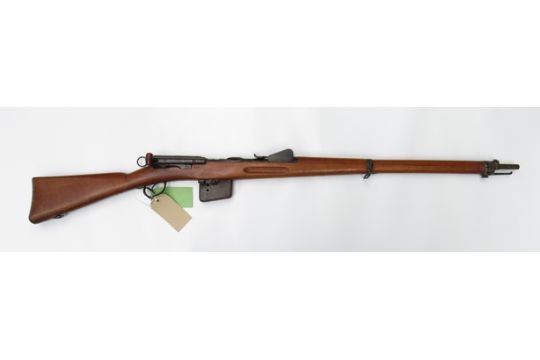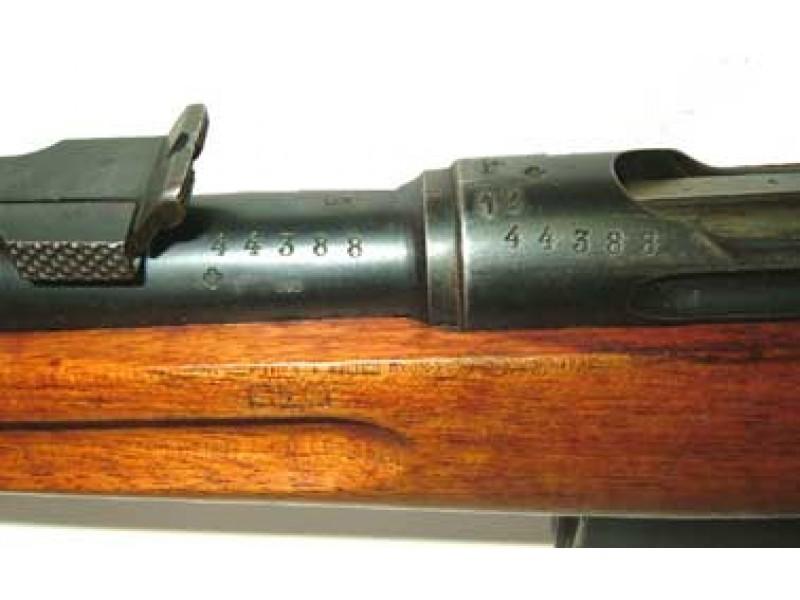- Schmidt Rubin 1889 Serial Nos Chart
- Schmidt Rubin 1889 Serial Number
- Schmidt Rubin 1889 Serial Nos 1
- Schmidt Rubin 1911 Serial Numbers
(Serial # 192 - Manufactured in 1891)
Dates of Production by Model for Swiss Military Schmidt-Rubin Rifles. Model 1889/1900 Short Rifles. Schmidt Rubin Model 1889 7.5 x 53.5mm Serial No: 108288 Date: 1892 Obsolete Calibre. This example is in Excellent Condition Manufactured in 1891, matching numbers on the Bolt, Magazine & Action.
PLEASE SUPPORT MAC ON PATREON (we are viewer supported): take out a Schmidt–Rubin 1889 7.5x53.5 caliber straight pull.
 (Click PIC to Enlarge)
(Click PIC to Enlarge)Calibre: ........................ 7.5 x 53.5 Swiss (GP90 & GP 90/03) See Note #2 below
.................................... 7.5 x 54.5 Swiss (GP90/23) See Note #2 below
Rifling & Twist: .............. 3-groove, RH, concentric rifling, 1 in 10.63
Barrel Length: ............... 30.7 in. (780mm)
Overall Length: ............. 51.25 in.(1302mm)
Weight: ........................ 10.69 lbs. (4.85kg) (empty)
Magazine Capacity: ....... 12 round detachable box magazine
Qty Mfg: ....................... ~212,000
Source: ....................... Swiss Magazine Loading Rifles, 1869 to 1958
................................... by Joe Poyer - ISBN: 1882391322
Canadian Collector Market Value Estimate: $
1891 Model 1889 Schmidt Rubin Infantry Rifle
(62 picture virtual tour)
Observations:(Courtesy of Guisan - Copyright SwissRifles.com)
This rifle was officially adopted on June 26, 1889. Tooling had already begun in the state factory, and so the first deliveries were surprisingly speedy. The M1889 was a most unusual design, with a characteristically Swiss nose cap/bayonet lug/stacking rod assembly, and a receiver with a noticeable gap between the trigger guard and the magazine. The great length of the bolt weakened the Schmidt system greatly. Production ceased in 1897 after 211,890 rifles and 40-50 drill rifles (Exerzierwaffen) had been delivered.
Collector's Comments and Feedback:
1.
 The rifle displayed in the virtual tour pictorial was manufactured in 1891 and is one of the first 200 rifles of this model ever built. It is all matching and is complete with the first model 1889 muzzle cover, correct for M1889 rifles within serial number range #1 to #19301. It's also mounted with the special removable clip to hold magazine lever in down position, often missing from these rifles.(Feedback by 'Badger')
The rifle displayed in the virtual tour pictorial was manufactured in 1891 and is one of the first 200 rifles of this model ever built. It is all matching and is complete with the first model 1889 muzzle cover, correct for M1889 rifles within serial number range #1 to #19301. It's also mounted with the special removable clip to hold magazine lever in down position, often missing from these rifles.(Feedback by 'Badger')
Schmidt Rubin 1889 Serial Nos Chart
2. CAUTION:
 DO NOT shoot the M1889 Schmidt-Rubin using standard 7.5 x 55 Swiss (GP11) military surplus ammunition. The chamber of the M1889 was not designed to handle the pressures generated by the more modern GP11 round. The Model 1889 action was designed to handle rounds that generated at most 39,000 psi, while GP11 rounds produce 45,500 psi. It is safe to fire modern 7.5 x 55 Swiss (GP11) rounds in Model 1896/11s, 1911s and K31s. If you wish to fire your M1889, you are going to have to reload your own cartridges. (Feedback by 'Badger')
DO NOT shoot the M1889 Schmidt-Rubin using standard 7.5 x 55 Swiss (GP11) military surplus ammunition. The chamber of the M1889 was not designed to handle the pressures generated by the more modern GP11 round. The Model 1889 action was designed to handle rounds that generated at most 39,000 psi, while GP11 rounds produce 45,500 psi. It is safe to fire modern 7.5 x 55 Swiss (GP11) rounds in Model 1896/11s, 1911s and K31s. If you wish to fire your M1889, you are going to have to reload your own cartridges. (Feedback by 'Badger')
Schmidt Rubin 1889 Serial Number
3. It is true that you should not fire GP-11 in a M1889, but the chamber isn't the reason. The concern is instability buckling failure of the bolt. In the Lg1889, the locking lugs are at the rear of the locking sleeve. The bolt assembly acts as long column with a wobbly joint in midspan. In the Lg1889/96, the lugs were moved to the front of the locking sleeve and made a little larger. This made the bolt 'column' significantly shorter and stabilized the back end, eliminating the 'wobbly joint'. The larger contact area of the lugs allows for higher pressures without increasing stresses. Thus, when the GP-11 cartridge was developed, the Lg 1889/96 was suitable for rebarreling to the 7.5 x 55 cartridge, and nearly all of that model were so-converted and became known as the Lg 96/11. It was determined that the original Lg1889 was not suitable for conversion because of the bolt issue. The GP-90/23 cartridge was developed for the Lg 1889 so that users of that obsolescent arm would have a full metal jacket cartridge. Firing of GP-11 ammunition in Lg 1889 rifles was not authorized, except during the WW II emergency, when reservists and Landsturm who still held the rifle were told that they could use the GP-11 for 'war emergency use' only.The original GP-90 cartridge had a lead alloy bullet with an iron or mild steel 'cap' at the nose; the assembly was then paper-patched. The bullet miked about .320-.321 over the patching. The neck of the 7.5 x 53.5 chamber was overly large to accomodate this projectile; and the leade of the chamber was both long and the angle very shallow to guide the projectile into the bore wihout tearing the paper patch. This is the reason that the Lg1889 did not perform paticularly well with GP-90/23, and the reason they don't do real well with our typical .308' bullet handloads (as compared to the rest of the S-R family and the K31).
I have done chamber casts of the three that I own; the length of the chambers on all is substantially greater than the '53.3' of the cartridge name. In fact, the chambers are long enough, and the chamber mouth is of such diameter that 'pinching' of the case mouth of an errantly-fired GP-11 cartridge would not be an issue. A GP-11 cartridge would not be expected to generate pressure higher than that generated in a proper 7.5 x 55 chamber, and infact might be a little lower because of the freebore that the GP-11 bullet 'sees' in that chamber ... but the pressure developed would be too much for the weaker, wobbly 1889 bolt to tolerate for any length of time.
Take Poyer's book with many grains of salt. Lots of errors in there. (Feedback by 'Bob S')
K31 modifications history
Schmidt Rubin 1889 Serial Nos 1
| 1934 | The firing pin was lightened. |
| 1935 | The receiver was made from hardened steel. |
| 1936 | The magazine was made from hardened steel. |
| 1941 | Stocks made from laminated plywood were tested, but rejected. |
| 1944 | Due to supply shortages, Chromium Molybdenum Steel was use in place of Chromium Nickel Steel on various parts. (Recognisable by “+CM” markings instead of the usual “+CN” markings) This experiment proved unsuccessful. |
| 1946 | Starting with K31 serial number 868,901, beech wood rather than walnut wood was used for making the stocks. |
Serial numbers and manufacturing dates
Source: Manufacture Dates of Swiss Schmidt-Rubin Rifles
Swiss Schmidt-Rubin rifles do not have the date of manufacture stamped on any of the rifle parts, so determining when the rifle (and mismatched parts, if any) were manufactured must be determined from the serial numbers. The definitive work on this subject, and Schmidt-Rubin rifles in general, is Die Repetiergewehre der Schweiz, Die Systeme Vetterli und Schmidt-Rubin, by Reinhart, Sallaz, and am Rhyn (ISBN 3-7276-7102-5, copyright 1991 by Verlag Stocker-Schmid AG, Dietikon-Zuerich, Schweiz), from which the tables given here are adapted.
| Year | Quantity | Serial numbers |
|---|---|---|
| 1933 | 1193 | 520010-521202 |
| 1934 | 15534 | 521203-536736 |
| 1935 | 13664 | 536737-550400 |
| 1936 | 11326 | 550401-561727 |
| 1937 | 11639 | 561728-573366 |
| 1938 | 10344 | 573367-583700 |
| 1939 | 15300 | 583701-599000 |
| 1940 | 33575 | 599001-632575 |
| 1941 | 54150 | 632576-686725 |
| 1942 | 49350 | 686726-736075 |
| 1943 | 50475 | 736076-786550 |
| 1944 | 51900 | 786551-838450 |
| 1945 | 26200 | 838451-864650 |
| 1946 | 15600 | 864651-880250 |
| 1947 | 20950 | 880251-901200 |
| 1948 | 20100 | 901201-921300 |
| 1949 | 15500 | 921301-936800 |
| 1950 | 13200 | 936801-950000 |
| 1951 | 23050 | 950001-973050 |
| 1952 | 21400 | 973051-994450 |
| 1953 | 5549 7450 | 994451-999999 215001-222450 |
| 1954 | 17150 | 222451-239600 |
| 1955 | 11250 | 239601-250850 |
| 1956 | 6400 | 250851-257250 |
| 1957 | 2950 | 257251-260200 |
| 1958 | 3130 | 260201-263330 |
| Year | Quantity | Serial numbers |
|---|---|---|
| 1934 | 16 | ? |
| 1935 | 500 | 400001-400500 |
| 1936 | 100 Zoll | 401001-401100 |
| 1937 | 150 Zoll 200 | 401101-401250 400501-400700 |
| 1938 | 150 | 400701-400850 |
| 1939 | 20 | 401501-401520 |
| 1940 | 150 530 50 50 | 400851-401000 401521-402050 402151-402220 402251-402300 |
| 1941 | 300 | 402301-402600 |
| 1942 | 650 | 402501[sic]-403150[sic] |
| 1943 | 350 | 403151-403500 |
| 1944 | 400 | 403501-403900 |
| 1945 | 600 | 403901-404500 |
| 1946 | 837 | 404501-405337 |
| 1947 | 929 30 | 405322[sic]-406250 E519767-E519796 |
| 1948 | 400 | 406251-406650 |
| 1949 | 650 | 406651-407300 |
| 1950 | 400 50 | 407301-407700 408001-408050 |
| 1951 | 300 50 | 407701-408000 408051-408100 |
| 1952 | 300 | 408101-408400 |
| 1953 | 450 50 | 408401-408850 409051-409100 |
| 1954 | 200 100 | 408851-409050 409101-409200 |
| 1955 | 450 100 | 409201-409650 410151-410250 |
| 1956 | 450 | 409651-410100 |
| 1957 | 50 300 | 410101-410150 410251-410550 |
| 1958 | 475 | 410551-411025 |
| 1959 | 425 | 411026-411450 |
| 1960 | 300 | 411451-411750 |
| 1961 | 300 | 411751-412050 |
| 1962 | 400 | 412051-412450 |
| 1963 | 50 400 | 267331-267380 412451-412850 |
| 1968-1969 | 150 | various numbers |
| 1971 | 150 50 | 269431-269580 269881-269930 |
| Stand (?) 1972 | 250 | various numbers |
Schmidt Rubin 1911 Serial Numbers
Note:
Zoll – Customs service
| Serial numbers | Allocation |
|---|---|
| 215001-350000 | K31 Carbine series, ordered by KTA for KMV |
| 350001-400000 | K31 Carbine series |
| P400001-P450000 | Private K31 Carbine series |
| 450001-500000 | K31 Carbines with telescopic sights (sniper versions) |
| 500001-500200 | Trials versions |
| E519701-E519900 | Various special K31s |
| 519901-519999 | Cutaway K31s (running backwards?), last number 519970 |
| 520001-520150 | Carbine series ordered by KTA, delivered by W+F for special purposes |
| 520081-520100 | Ditto, reserved for W+F |
| 520151-999999 | Carbine series, ordered by KTA for KMV |
| after 550651 | Hardened magazine boxes |
| after 540001 | Hardened receivers |
Notes:
KTA – Kriegstechnischen Abteilung des schweizerischen Militaerdepartements
KMV – Kriegsmaterialverwaltung
W+F – Waffenfabrik